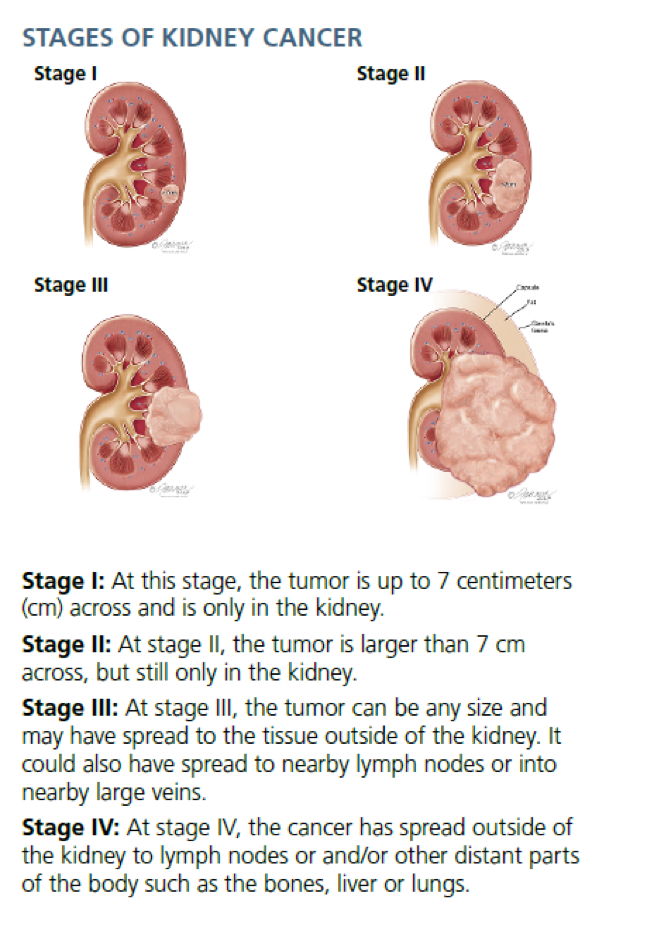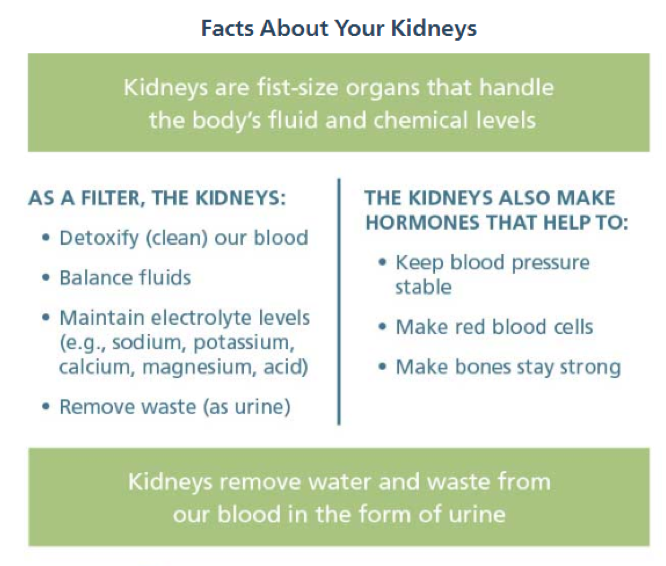Kidney Cancer Resources for Patients
Pre - Treatment
A renal mass is an abnormal growth in the kidney. Renal (kidney) masses may be solid or fluid-filled (or cystic). Most cysts are benign (not cancerous), but some with complex features can contain cancer cells. Masses that are not cysts (tumors) are more commonly cancerous (malignant) than benign. The majority are small, localized (not spread outside of the kidney) masses. The four types of renal tumors are:
- Renal Cell Carcinomas (RCC): most common malignant (cancerous) kidney tumor. Various subtypes of RCC develop in various parts of the meat (parenchyma) of the kidney. RCC may occur as a single or multiple tumors.
- Benign renal tumors: non-cancerous tumors that are commonly small and do not spread to other organs. Occasionally, they can grow quite large and cause symptoms. There are more than 9 different types of tumors in this class.
- Urothelial carcinoma (UC): cancer that develops in the lining cells of the urinary system (urothelium). UC can occur in the kidney, ureter, bladder, or urethra. Treatment for this cancer follows a completely different path than for RCC.
- Wilms tumor: most commonly found in children; treatment protocols are different than for RCC.
Click on the video below to learn more about kidney masses:
Content found within askMUSIC is provided by the Urology Care Foundation.
Most patients with renal masses have no symptoms in the early stages. The most common symptoms experienced include the following:
- Hematuria (blood in the urine)
- Flank pain (pain between the ribs and hips)
- Loss of appetite
- Weight loss
- Fever
- Anemia (low red blood cell count)
Content found within askMUSIC is provided by the Urology Care Foundation.
The cause for most kidney cancers is unknown, but the following factors can increase your risk:
- Smoking
- Drinking alcohol in excess
- Obesity, poor dietary habits
- Family history of high blood pressure
- Being on dialysis for kidney failure
- Workplace exposure to chlorinated chemicals
- Heredity (some kidney cancers are passed on genetically from family members to others)
- Prior history of kidney cancer
Content found within askMUSIC is provided by the Urology Care Foundation.
Kidney masses are often found when your doctor has ordered an abdominal imaging test for any of a wide range of different health conditions. If a kidney mass is identified, you may be recommended to see a urologist, a doctor who specializes in treating diseases/conditions in the urinary system. Your primary care provider may ask you to undergo additional tests to help make a diagnosis, such as:
- Blood tests
- Basic metabolic panel (BMP) or complete metabolic panel (CMP) – to evaluate organ function
- Complete Blood Count (CBC) – to measure the number of each cell type in your blood, checking for abnormalities that may be a sign of disease.
- Urinalysis: to check for infection, blood and protein in your urine.
- Imaging test:
- CT or MRI scans – to diagnose and stage the renal mass
- Chest X-ray or CT – to determine whether cancer has spread to the chest
- Biopsy: to determine what type of tumor you have
- During a renal mass biopsy, a small amount of tissue from the kidney is removed and viewed under a microscope to look for abnormal cells (cancer). A biopsy helps to determine the best next step for diagnosis and treatment.
Staging and Grading:
If your renal mass biopsy shows cancerous (abnormal) cells, your doctor will stage the cancer using the TNM system.
T = size of the main (primary) tumor and if it has grown into nearby areas
- Classified as T1 – T4 based on tumor size and containment/extension
N = spread of cancer to nearby lymph nodes (small collections of immune system cells that are located throughout the body)
- Classified as N0: no regional lymph node metastasis or N1: metastasis in regional lymph node(s)
M = spread (metastasis) of cancer to other parts of the body.
- Classified as M0: No distant metastasis or M1: Distant metastasis
The cancer is graded by a doctor looking at your renal mass biopsy tissue under a microscope, to determine tumor aggressiveness on a scale of 1-4. A score of “1” indicates the lowest while a “4” indicates the highest level. Higher scores indicate more aggressive tumor behavior.

Tumor Size and Complexity:
The larger and more infiltrative a tumor is, the greater risk the cancer may spread outside of the kidney to other parts of the body. Tumor stage takes into account the largest diameter of the tumor, grouping tumors into T1a: ≤4.0 cm, T1b: 4.1 to 7.0 cm, T2a 7.1 to 10 cm, and T2b if >10 cm and localized. Tumor complexity is a measure of how challenging it would be to remove the mass from the remainder of the kidney. A low complexity tumor is located mostly outside of the kidney (exophytic), while a high complexity tumor is mostly within the kidney (endophytic). Several scoring systems exist to quantify tumor complexity. In MUSIC-KIDNEY, we determine complexity using a 4 component nephrometry score (RENL) with a range from 4 to 12.
Content found within askMUSIC is provided by the Urology Care Foundation.
The following may help reduce your risk for renal cancer and improve your overall wellness:
- Stop smoking
- Limit alcohol intake
- Maintain a healthy diet
- Eat fruits and vegetables, like broccoli, brussel sprouts, cabbage, or collard greens
- Add fatty fish into your diet, such as salmon or tuna
- Exercise regularly
Content found within askMUSIC is provided by the Urology Care Foundation
Treatment and Post - Treatment
Your doctor will evaluate you as an individual (overall health, medical conditions, family and social history), the specific features of your tumor (size, complexity, stage, grade and rate of growth), your preferences, and the outcomes associated with each type of treatment to help you decide on the best course for your care. Regardless of what treatment you choose, it is important to stay in touch with your doctor and return for all follow-up appointments. Follow-up testing and visits are important to monitor and watch for any signs of illness and any growth or return of tumors.
To learn more about treatment options for kidney cancer, please click on the image below:
Content found within askMUSIC is provided by the Urology Care Foundation.
Active Surveillance (AS): closely monitoring the tumor without active treatment, maintain kidney function, and avoid potential sice effects of treatment.
You will come back to the office at certain time points, every 3-, 6-, or 12-months as necessary, depending on your tumor size and stage. At these times, follow up tests or imaging, such as CT scan, renal ultrasound, or chest X-ray may be performed.
Side effects: while there are no side effects from AS, you may need to later transition to a more active treatment if your cancer begins to grow or spread.
Content found within askMUSIC is provided by the Urology Care Foundation.
Surgery: To remove part or all of the small renal mass tumor. The two types of kidney cancer surgery are:
- Partial Nephrectomy – removing part of the kidney or diseased portion and leaving the healthy part of the kidney.
- Radical Nephrectomy – removing the entire kidney; your body can function well with one kidney if one is removed.
Side effects: surgery carries a risk of bleeding and infection. Other less common side effects of surgery may include potential damage to other organs, urinary problems or failure of the second kidney.
Content found within askMUSIC is provided by the Urology Care Foundation.
Non-surgical methods may be used if surgery is not possible or not recommended. These options can include:
- Cryoablation: freezing and destroying the tumor cells.
- Radiofrequency Ablation: heating and destroying the tumor cells.
- Arterial Embolization: plugging the blood vessels feeding the tumor.
Side effects: non-surgical options have fewer side effects than surgery. However, cancer recurrence is more common than with surgery.
Content found within askMUSIC is provided by the Urology Care Foundation.
Systemic therapies treat cancer cells wherever they may be in the body.
- Targeted therapy uses drugs to “target” and treat specific types of cancer cells, such as renal cell carcinoma (RCC). These can shrink or slow the growth of cancer for a while. Rarely do they eliminate all kidney cancer cells.
- Immunotherapy uses your body’s immune system to help fight off or destroy cancer cells. Checkpoint inhibitors are effective in treating advanced kidney cancer, with mild side effects in most patients. Cytokine therapy has been reported to cure kidney cancer in some patients, but is rarely used because of significant side effects.
Side effects: vary depending on which option you choose. Talk with your urologist or medical oncologist to learn more.
Content found within askMUSIC is provided by the Urology Care Foundation.
Here are some questions that you may find helpful to ask and discuss with your doctor regarding your renal mass diagnosis:
- Do I have kidney cancer?
- What is the stage (and grade) of my cancer and what does that mean?
- Has the mass spread anywhere else?
- Is the mass likely to grow or spread some more?
- Do I need other tests before we can decide on treatment?
- What are my treatment choices? Which do you think I should choose, and why?
- What should I expect after the procedure?
- Will I have a lot of pain? How will my pain be managed?
- How likely is it that I will beW cured after treatment?
- What are the chances that the mass will return after treatment?
- What risks or side effects should I expect from treatment? For how long?
- What can I do to keep my remaining kidney(s) functioning in a healthy manner?
- What should I do to get myself ready for treatment?
- What will we do if the treatment doesn’t work?
- Can you recommend another urologist for a second opinion?
- What more can I do to improve my health?
- What type of follow-up will I need after treatment? For how long?
- How long will I need to stay in the hospital?
- Following surgery, will I need additional treatment?
Content found within askMUSIC is provided by the Urology Care Foundation.





